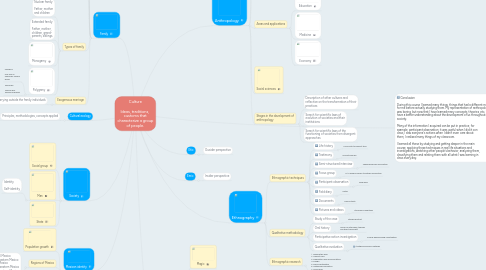
1. Family
1.1. Affinity
1.1.1. Relationships that links through marriage
1.2. Otherness
1.2.1. Others as interpersonal phenomenon
1.3. Ethnocentrism
1.3.1. Judging cultures with own standards
1.4. Acculturation
1.4.1. Exchange of cultural features through direct contact
1.5. Enculturation
1.5.1. Learning process through observation of own society
1.6. Types of family
1.6.1. Nuclear family Father, mother and children
1.6.2. Extended family Father, mother, children, grand- parents, siblings.
1.6.3. Monogamy
1.6.4. Polygamy
1.6.4.1. Polygyny One man is shared by several wives
1.6.4.2. Polyandry Woman has several husbands
1.7. Exogamous marriage
1.7.1. Marrying outside the family individuals
2. Mexican identity
2.1. Population growth
2.2. Regions of Mexico
2.2.1. Central Mexico Northeastern Mexico West Mexico Northwestern Mexico Southeastern Mexico
2.3. Regionalism
2.3.1. Soil History Living together
3. Society
3.1. Social group
3.2. Man
3.2.1. Identity Self-identity
3.3. State
4. Cultural ecology
4.1. Principles, methodologies, concepts applied
5. Anthropology
5.1. Subdisciplines
5.1.1. Physical anthropology
5.1.1.1. Physical characteristics of humans
5.1.2. Archaeology
5.1.2.1. Material remains of past cultures
5.1.3. Cultural anthropology
5.1.3.1. Analysis and description of cultures
5.1.4. Anthropological linguistics
5.1.4.1. Diversity of languages spoken by the groups
5.2. Theories
5.2.1. Evolutionist school
5.2.1.1. History has developed progressively and continously
5.2.2. Historical particularism
5.2.2.1. Based on insufficient empirical evidence
5.2.3. Diffusionism
5.2.3.1. Adoption by imitation
5.2.4. Functionalism
5.2.4.1. Describe the functions and institutions for the society
5.2.5. Culture and personality, the influence of Freud in anthropology
5.2.5.1. Linking cultural aspects of the individual by his personality and vice versa
5.2.6. Neoevolutionism
5.2.6.1. The existance of a cultural evolution determined by the energy captured and executed in person
5.2.7. French structuralism
5.2.7.1. Differences and similarities among cultures
5.3. Areas and applications
5.3.1. Education
5.3.2. Medicine
5.3.3. Economy
5.4. Social sciences
5.5. Stages in the development of anthropology
5.5.1. Description of other cultures and reflection on the transformation of their practices
5.5.2. Search for scientific laws of evolution of societies and their institutions
5.5.3. Search for scientific laws of the functioning of societies from divergent approaches
6. Etic
6.1. Ousider perspective
7. Ethnography
7.1. Ethnographic techniques
7.1.1. Life history
7.1.1.1. From birth to present time
7.1.2. Testimony
7.1.2.1. Minority groups
7.1.3. Semi-structured interview
7.1.3.1. Seeking specific information
7.1.4. Focus group
7.1.4.1. 6-12 people chosen to gather information
7.1.5. Participant observation
7.1.5.1. Field work
7.1.6. Field diary
7.1.6.1. Notes
7.1.7. Documents
7.1.7.1. Official texts
7.1.8. Pictures and videos
7.1.8.1. Styles and conditions
7.2. Qualitative methodology
7.2.1. Study of the case
7.2.1.1. Integral portrait
7.2.2. Oral history
7.2.2.1. Group of interviews, tapings and their transcripts
7.2.3. Participative action investigation
7.2.3.1. Include people being investigated
7.2.4. Qualitative evaluation
7.2.4.1. It gathers previous methods
7.3. Ethnographic research
7.3.1. 1. Marking the field 2. Subject field 3. Preparation and documentation 4. Design 5. Field investigation 6. Gathering information 7. Conclusion
8. Religion
8.1. Magic
8.2. Myth
8.3. Sacred
8.3.1. Rituals that creates relatinoships
8.4. Profane
8.4.1. Ordinary events
8.5. Type of cults
8.5.1. Individualist Social established instructions
8.5.2. Shamanist Carries out activity from time to time
8.5.3. Community Individuals grouped
8.5.4. Ecclesiastical Full time commitment
